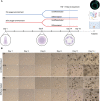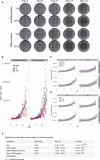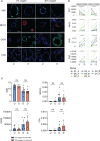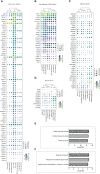Physiological hypoxia improves growth and functional differentiation of human intestinal epithelial organoids
- PMID: 36793710
- PMCID: PMC9922616
- DOI: 10.3389/fimmu.2023.1095812
Physiological hypoxia improves growth and functional differentiation of human intestinal epithelial organoids
Abstract
Background: The epithelium in the colonic mucosa is implicated in the pathophysiology of various diseases, including inflammatory bowel diseases and colorectal cancer. Intestinal epithelial organoids from the colon (colonoids) can be used for disease modeling and personalized drug screening. Colonoids are usually cultured at 18-21% oxygen without accounting for the physiological hypoxia in the colonic epithelium (3% to <1% oxygen). We hypothesize that recapitulating the in vivo physiological oxygen environment (i.e., physioxia) will enhance the translational value of colonoids as pre-clinical models. Here we evaluate whether human colonoids can be established and cultured in physioxia and compare growth, differentiation, and immunological responses at 2% and 20% oxygen.
Methods: Growth from single cells to differentiated colonoids was monitored by brightfield images and evaluated with a linear mixed model. Cell composition was identified by immunofluorescence staining of cell markers and single-cell RNA-sequencing (scRNA-seq). Enrichment analysis was used to identify transcriptomic differences within cell populations. Pro-inflammatory stimuli induced chemokines and Neutrophil gelatinase-associated lipocalin (NGAL) release were analyzed by Multiplex profiling and ELISA. Direct response to a lower oxygen level was analyzed by enrichment analysis of bulk RNA sequencing data.
Results: Colonoids established in a 2% oxygen environment acquired a significantly larger cell mass compared to a 20% oxygen environment. No differences in expression of cell markers for cells with proliferation potential (KI67 positive), goblet cells (MUC2 positive), absorptive cells (MUC2 negative, CK20 positive) and enteroendocrine cells (CGA positive) were found between colonoids cultured in 2% and 20% oxygen. However, the scRNA-seq analysis identified differences in the transcriptome within stem-, progenitor- and differentiated cell clusters. Both colonoids grown at 2% and 20% oxygen secreted CXCL2, CXCL5, CXCL10, CXCL12, CX3CL1 and CCL25, and NGAL upon TNF + poly(I:C) treatment, but there appeared to be a tendency towards lower pro-inflammatory response in 2% oxygen. Reducing the oxygen environment from 20% to 2% in differentiated colonoids altered the expression of genes related to differentiation, metabolism, mucus lining, and immune networks.
Conclusions: Our results suggest that colonoids studies can and should be performed in physioxia when the resemblance to in vivo conditions is important.
Keywords: chemokines (cytokines); differentiation; inflammatory bowel disease; intestinal epithelial cells (IECs); oxygen; proliferation; single-cell RNA-sequencing (scRNAseq); transcriptome.
Copyright © 2023 Walaas, Gopalakrishnan, Bakke, Skovdahl, Flatberg, Østvik, Sandvik and Bruland.
Conflict of interest statement
The authors declare that the research was conducted in the absence of any commercial or financial relationships that could be construed as a potential conflict of interest.
Figures







Similar articles
-
Comprehensive protocols for culturing and molecular biological analysis of IBD patient-derived colon epithelial organoids.Front Immunol. 2023 Feb 23;14:1097383. doi: 10.3389/fimmu.2023.1097383. eCollection 2023. Front Immunol. 2023. PMID: 36911731 Free PMC article.
-
Patient Derived Colonoids as Drug Testing Platforms-Critical Importance of Oxygen Concentration.Front Pharmacol. 2021 May 13;12:679741. doi: 10.3389/fphar.2021.679741. eCollection 2021. Front Pharmacol. 2021. PMID: 34054553 Free PMC article.
-
Patient-derived colon epithelial organoids reveal lipid-related metabolic dysfunction in pediatric ulcerative colitis.bioRxiv [Preprint]. 2024 Oct 22:2024.08.22.609271. doi: 10.1101/2024.08.22.609271. bioRxiv. 2024. PMID: 39229116 Free PMC article. Preprint.
-
Development, validation and implementation of an in vitro model for the study of metabolic and immune function in normal and inflamed human colonic epithelium.Dan Med J. 2015 Jan;62(1):B4973. Dan Med J. 2015. PMID: 25557335 Review.
-
Understanding disruption of the gut barrier during inflammation: Should we abandon traditional epithelial cell lines and switch to intestinal organoids?Front Immunol. 2023 Feb 16;14:1108289. doi: 10.3389/fimmu.2023.1108289. eCollection 2023. Front Immunol. 2023. PMID: 36875103 Free PMC article. Review.
Cited by
-
Tofacitinib and budesonide treatment affect stemness and chemokine release in IBD patient-derived colonoids.Sci Rep. 2025 Jan 30;15(1):3753. doi: 10.1038/s41598-025-86314-2. Sci Rep. 2025. PMID: 39885201 Free PMC article.
-
Novel mechanisms of intestinal flora regulation in high-altitude hypoxia.Heliyon. 2024 Sep 20;10(20):e38220. doi: 10.1016/j.heliyon.2024.e38220. eCollection 2024 Oct 30. Heliyon. 2024. PMID: 39498080 Free PMC article.
-
Gastruloid optimization.Emerg Top Life Sci. 2023 Dec 18;7(4):409-415. doi: 10.1042/ETLS20230096. Emerg Top Life Sci. 2023. PMID: 37815089 Free PMC article.
-
Standard: Human intestinal organoids.Cell Regen. 2023 Jun 14;12(1):23. doi: 10.1186/s13619-023-00168-5. Cell Regen. 2023. PMID: 37314549 Free PMC article.
-
Comprehensive protocols for culturing and molecular biological analysis of IBD patient-derived colon epithelial organoids.Front Immunol. 2023 Feb 23;14:1097383. doi: 10.3389/fimmu.2023.1097383. eCollection 2023. Front Immunol. 2023. PMID: 36911731 Free PMC article.
References
Publication types
MeSH terms
Substances
LinkOut - more resources
Full Text Sources
Molecular Biology Databases
Research Materials
Miscellaneous

